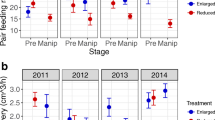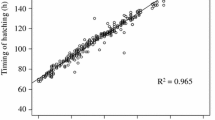Summary
According to the Peak Load Reduction Hypothesis, avian parents establish within-brood hatching asynchrony (via early incubation of first-laid eggs) in order to lower the maximum level of the brood's daily food demands. By offsetting the individual demand curves by a day or more, parents may be able to achieve adaptive levels of effort relief. We examined the potential parental savings from this strategy by developing a simple analytical model wherein individual offspring demand curves were either aligned (as in synchronous hatching) or displaced by a hatching interval variable (asynchronous hatching). Parental savings were calculated for various common brood sizes and hatching intervals.
The results show that substantial savings can accrue to parents if both broods and hatching intervals are large or if individual demand curves rise to a high, narrow peak. However, the parameter values necessary for load reductions of even 5% appear seldom, if ever, met in nature. Unless very small savings have disproportionate value to parents, it seems unlikely that hatching asynchrony evolved because of its direct effects on trimming parental effort. The possibility remains open that adaptive levels of parental savings could result from a secondary interaction between a modest initial hatching interval and consequent competition among nestlings, which can greatly amplify the chicks' growth rate differences.
Similar content being viewed by others
References
Amundsen, T. and Stokland, J. N. (1988) Adaptive significance of asynchronous hatching in the shag: a test of the brood reduction hypothesis.J. Anim. Ecol. 57, 329–44.
Bryant, D. M. (1978) Establishment of weight hierarchies in the broods of house martinsDelichon urbica.Ibis 120, 16–26.
Bryant, D. M. and Gardiner, A. (1979) Energetics of growth in house martins (Delichon urbica).J. Zool. Lond.189, 275–304.
Buitron, D. (1988) Female and male specialization in parental care and its consequences in black-billed magpies.Condor 90, 29–39.
Bunn, D. S., Warburton, A. B. and Wilson, R. D. S. (1982)The Barn Owl. Buteo Books, Vermillion, S.D.
Clark, A. B. and Wilson, D. S. (1981) Avian breeding adaptations: hatching asynchrony, brood reduction and nest failure.Quart. Rev. Biol. 56, 253–77.
Clark, A. B. and Wilson, D. S. (1985) The onset of incubation in birds.Amer. Nat. 125, 603–11.
Clark, L. (1984) Consequences of homeothermic capacity of nestlings on parental care in the European starling.Oecologia (Berl.)65, 387–93.
Crossner, K. (1977) Natural selection and clutch size in the European starling.Ecology 58, 885–92.
Davies, N. B. (1976) Farental care and the transition to independent feeding in the young spotted flycatcher.Behaviour 59, 280–95.
Drent, R. H. and Daan, S. (1980) The prudent parent: energetic adjustments in avian breeding.Ardea 68, 225–52.
Drummond, H., Gonzalez, E. and Osorno, J. (1986) Parent-offspring cooperation in the blue-footed booby,Sula nebouxii.Behav. Ecol. Sociobiol. 19, 365–72.
Dunn, E. H. (1979) Time-energy use and life history strategies of northern seabirds. InConservation of Marine Birds of Northern North America.Wildl. Res. Report No. 11 (J. C. Bartonek and D. N. Nettleship, eds) pp. 141–66. U.S. Fish & Wildlife Serv., Washington, D.C.
Edwards, T. C. Jr. and Collopy, M. W. (1983) Obligate and facultative brood reduction in eagles: an examination of factors that influence fratricide.Auk 100, 630–5.
Fujioka, M. (1985a) Food delivery and sibling competition in experimentally even-aged broods of the cattle egret.Behav. Ecol. Sociobiol. 17, 67–74.
Fujioka, M. (1985b) Feeding behaviour, sibling competition and siblicide in asynchronously hatching broods of the cattle egretBubulcus ibis.Anim. Behav. 33, 1228–42.
Gibb, J. (1950) The breeding biology of the great and blue titmice.92, 507–39.
Gibbons, D. (1987) Hatching asynchrony reduces parental investment in the jackdaw.J. Anim. Ecol. 56, 403–14.
Hahn, D. C. (1981) Asynchronous hatching in the laughing gull: cutting losses and reducing rivalry.Anim. Behav. 29, 421–7.
Hamilton, W. D. (1964) The genetical evolution of social behaviour, I & II.J. theor. Biol. 7, 1–52.
Howe, H. F. (1976) Egg size, hatching asynchrony, sex, and brood reduction in the common grackle.Ecology 57, 1195–207.
Howe, H. F. (1978) Initial investment, clutch size, and brood reduction in the common grackle (Quiscalus quiscula L.).Ecology 59, 1109–22.
Hussell, D. J. T. (1972) Factors affecting clutch-size in Arctic passerines.Ecol. Monogr. 42, 317–64.
Hussell, D. J. T. (1985) On the adaptive basis for hatching asynchrony: brood reduction, nest failure, and asynchronous hatching in snow buntings.Ornis Scandinavica 16, 205–12.
Ingram, C. (1959) The importance of juvenile cannibalism in the breeding biology of certain birds of prey.Auk 76, 218–26.
Inoue, Y. (1985) The process of asynchronous hatching and sibling competition in the little egretEgretta garzetta.Col. Waterbirds 8, 1–12.
Lack, D. (1947) The significance of clutch-size. Parts 1 & 2.89, 302–52.
Lack, D. (1954)The Natural Regulation of Animal Numbers. Clarendon Press, Oxford.
Lack, D. (1968)Ecological Adaptations for Breeding in Birds. Clarendon Press, Oxford.
Lamey, T. C. (In press) Hatch asynchrony and brood reduction in penguins. InPenguin Biology: Ecology, Ethology, Evolution and Ecophysiology (L. S. Davis and J. Darby, eds). Academic Press, N.Y.
Lessells, C. M. and Avery, M. I. (1989) Hatching asynchrony in European bee-eatersMerops apiaster.J. Anim. Ecol. 58, 815–35.
Magrath, R. D. (1989) Hatching asynchrony and reproductive success in the blackbird.Nature 339, 536–8.
Mead, P. S. and Morton, M. L. (1985) Hatching asynchrony in the mountain white-crowned sparrow (Zonotrichia leucophrys oriantha): a selected or incidental trait?Auk 102, 781–92.
Mikkola, H. (1983)Owls of Europe. Colton: T. and A. D. Poyser.
Mock, D. W. (1984) Infanticide, siblicide, and avian nestling mortality. InInfanticide: Comparative and Evolutionary Perspectives (G. Hausfater and S. B. Hrdy, eds) pp. 3–30. Aldine Publ. Co., New York.
Mock, D. W. (1985) Siblicidal brood reduction: the prey-size hypothesis.Amer. Nat. 125, 327–43.
Mock, D. W. (1987) Siblicide, parent-offspring conflict, and unequal parental investment by egrets and herons.Behav. Ecol. Sociobiol. 20, 247–56.
Mock, D. W. and Ploger, B. J. (1987) Parental manipulation of optimal hatch asynchrony in cattle egrets: an experimental study.Anim. Behav. 35, 150–60.
Murphy, E. C. and Haukioja, E. (1987) Clutch size in nidicolous birds.Current Ornithol. 5, 141–80.
Nur, N. (1984) Feeding frequencies of nestling blue tits (Parus caeruleus): costs, benefits and a model of optimal feeding frequency.Oecologia 65, 125–37.
O'Connor, R. J. (1978) Brood reduction in birds: selection for infanticide, fratricide, and suicide?Anim Behav. 26, 79–96.
O'Connor, R. J. (1984)The Growth and Development of Birds, J. Wiley & Sons, Chichester, U.K.
Ricklefs, R. E. (1983) Avian postnatal development. InAvian Biology (D. S. Farner, J. R. King and K. C. Parkes, eds) pp 1–89. Academic Press, New York.
Royama, T. (1966) Factors governing feeding rate, food requirement and brood size of nestling great tits Parus major.108, 313–47.
Shaw, P. (1985) Brood reduction in the blue-eyed shagPhalacrocorax atriceps.127, 476–94.
Skagen, S. K. (1988) Asynchronous hatching and food limitation: a test of Lack's hypothesis.Auk 105, 78–88.
Slagsvold, T. (1985) Asynchronous hatching in passerine birds: influence of hatching failure and brood reduction.Ornis Scand. 16, 81–7.
Slagsvold, T. (1986) Asynchronous versus synchronous hatching in birds: experiments with the pied flycatcher.J. Anim. Ecol. 55, 1115–34.
Slagsvold, T. and Lifjeld, J. T. (1989) Hatching asynchrony in birds: the hypothesis of sexual conflict over parental investment.Amer. Nat. 134, 239–53.
Slagsvold, T., Sandvik, J., Rofstad, G., Lorentsen, O. and Husby, M. (1984) On the adaptive value of intraclutch ogg-size variation in birds.Auk 101, 685–97.
Steyn, P. (1984) A Delight of Owls. Cape Town: D. Philip Publishers.
Trivers, R. L. (1974) Parent-offspring conflict.Amer. Zool. 14, 249–64.
Wilson, R. T., Wilson, M. P. and Durkin, J. W. (1986) Breeding biology of the barn owl (Tyto alba) in central Mali.128, 81–90.
Wynne-Edwards, V. C. (1962)Animal Dispersion in Relation to Social Behaviour Oliver and Boyd, Edinburgh.
Zach, R. (1982) Hatching asynchrony, egg size, growth and fledging in tree swallows.Auk 99, 695–700.
Author information
Authors and Affiliations
Rights and permissions
About this article
Cite this article
Mock, D.W., Schwagmeyer, P.L. The peak load reduction hypothesis for avian hatching asynchrony. Evol Ecol 4, 249–260 (1990). https://doi.org/10.1007/BF02214333
Issue Date:
DOI: https://doi.org/10.1007/BF02214333




